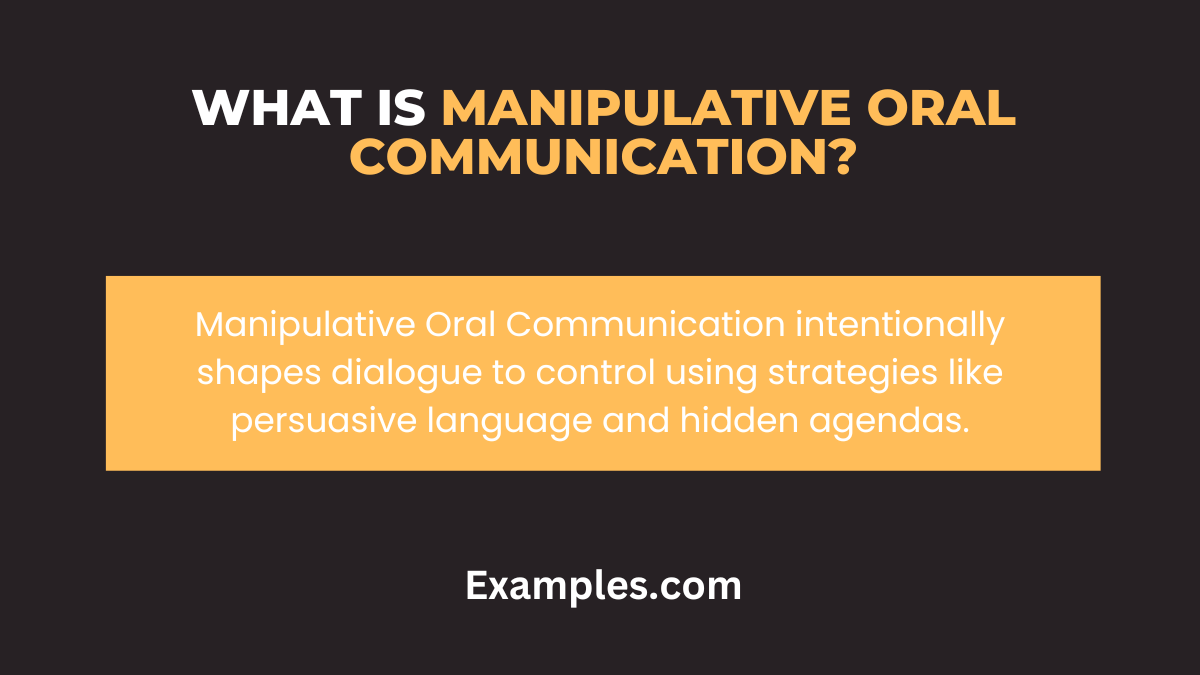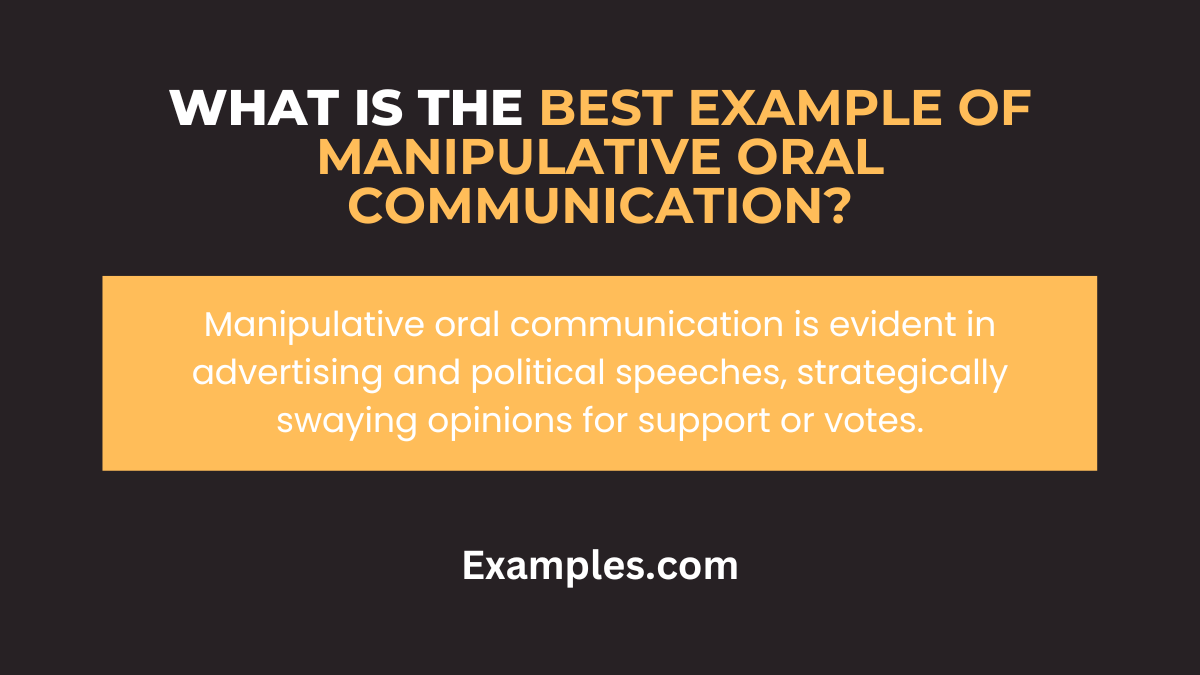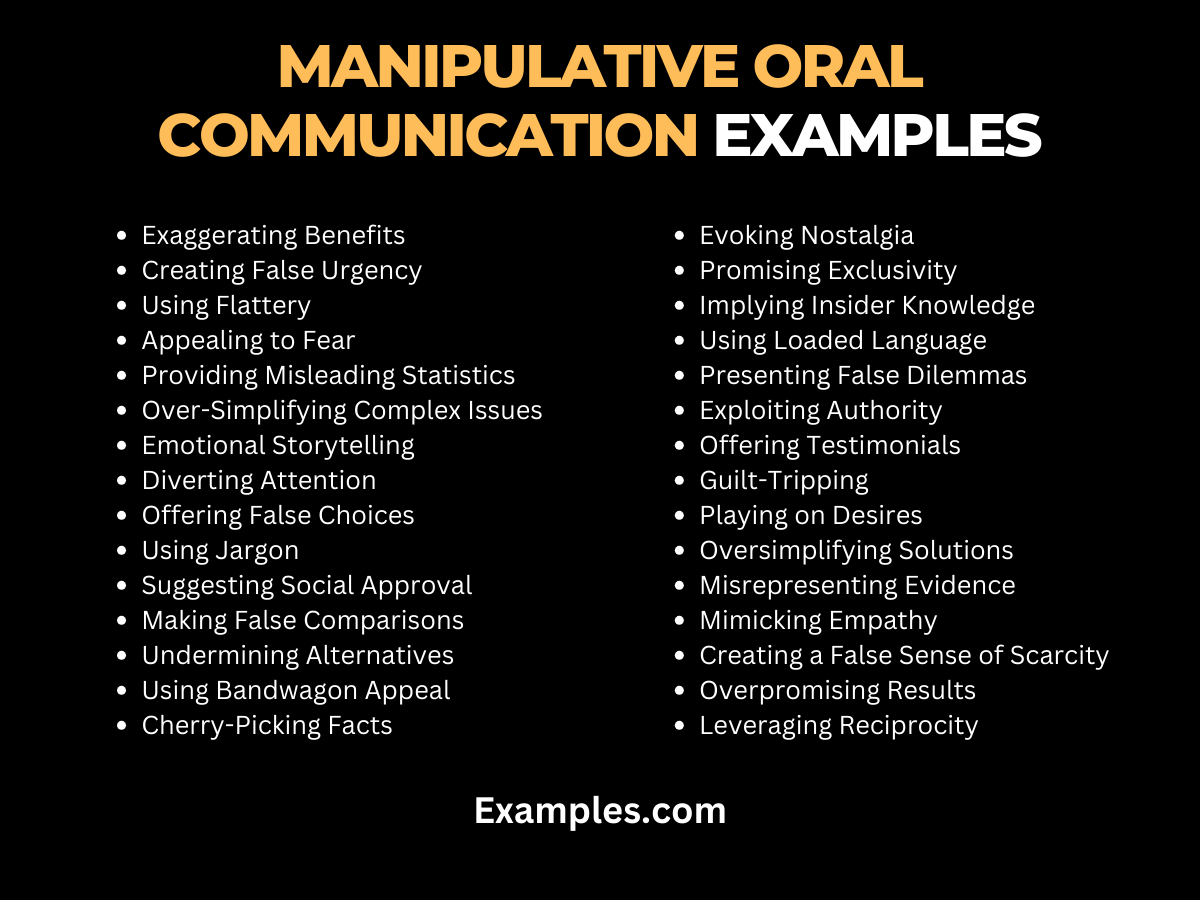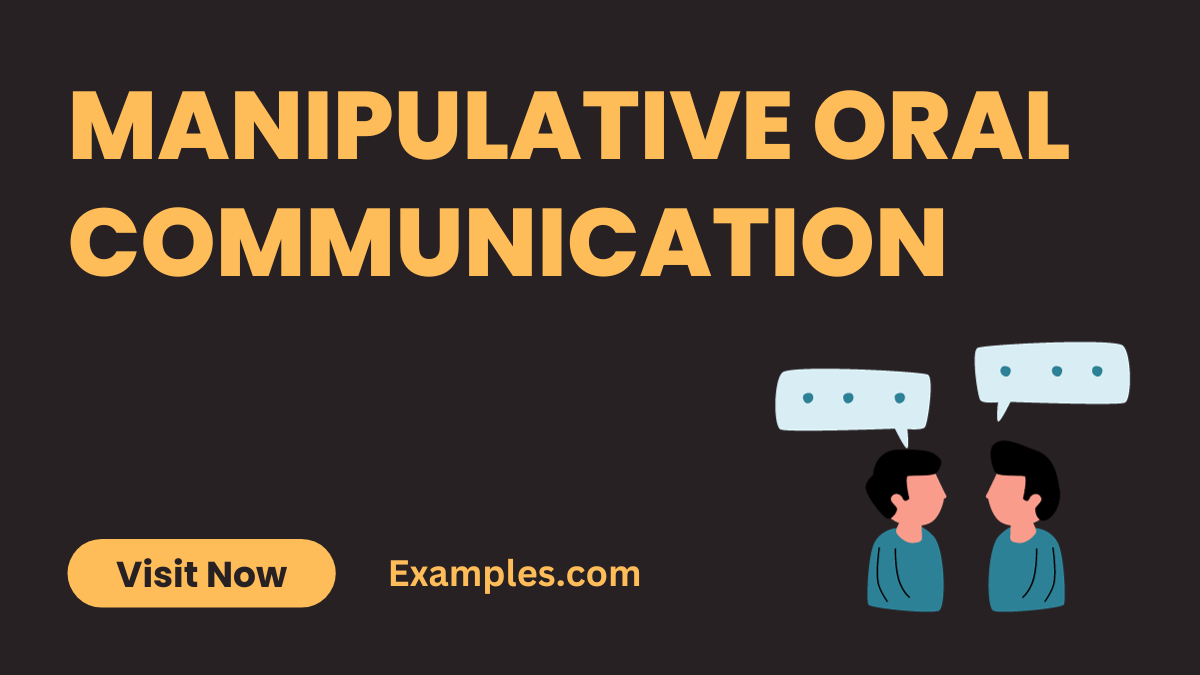Manipulative Oral Communication
Manipulative Oral Communication in the realm of Oral Communication is an intriguing strategy that involves skillfully influencing conversations to achieve desired outcomes. In this comprehensive guide, we’ll delve into the clear definition of Manipulative Oral Communication, providing real-world examples to enhance your understanding. Prepare to navigate conversations with precision and master the art of strategic communication.
What is Manipulative Oral Communication?

Manipulative Oral Communication is a type of oral communication where the speaker intentionally shapes the conversation to influence or control the listener. This form of communication often involves hidden agendas, misleading information, or emotional manipulation. Unlike straightforward or sincere communication, manipulative oral communication relies on strategies that are not always obvious to the listener.
In manipulative oral communication, the speaker might use persuasive language, emotional appeals, or selective information to steer the conversation towards a desired outcome. This approach can be seen in various contexts, from personal conversations to public speaking.
What is the Best Example of Manipulative Oral Communication?

One of the best examples of manipulative oral communication is in advertising. Advertisers often use persuasive language and emotional appeals to influence consumers’ buying decisions. They might exaggerate the benefits of a product or create a sense of urgency, pushing the audience towards making a purchase.
Another example is in politics, where a politician might use persuasive speeches to sway public opinion. They may strategically use language to evoke emotions, simplify complex issues, or divert attention from certain topics, all in an effort to gain support or votes.
30 Manipulative Oral Communication Examples

1. Exaggerating Benefits: Overstating a product’s advantages to persuade.
- Example: “This cream not only moisturizes but also reverses aging miraculously.”
- How to Communicate: Emphasize extreme benefits to create an irresistible offer.
2. Creating False Urgency: Implying limited time to force quick decisions.
- Example: “Buy now, or you’ll miss this once-in-a-lifetime opportunity!”
- How to Communicate: Use phrases suggesting immediate action is necessary.
3. Using Flattery: Complimenting to lower defenses and persuade.
- Example: “Someone as smart as you would definitely see the value in this.”
- How to Communicate: Offer compliments that make the listener feel special and wise.
4. Appealing to Fear: Playing on fears to motivate action.
- Example: “If you don’t act now, you might regret it forever.”
- How to Communicate: Highlight negative consequences of inaction.
5. Providing Misleading Statistics: Using skewed data to convince.
- Example: “9 out of 10 experts recommend our product.”
- How to Communicate: Present statistics that favor your argument, even if they’re not comprehensive.
6. Over-Simplifying Complex Issues: Making complicated topics seem simple to sway opinion.
- Example: “Solving this problem is as easy as using our software.”
- How to Communicate: Reduce complex issues to simple solutions.
7. Emotional Storytelling: Using emotive stories to connect and persuade.
- Example: “Our founder overcame poverty using this method.”
- How to Communicate: Share personal or emotional stories that resonate with the audience.
8. Diverting Attention: Shifting focus to avoid difficult questions.
- Example: “Let’s not focus on the cost; think about the benefits!”
- How to Communicate: Redirect the conversation to more favorable topics.
9. Offering False Choices: Presenting limited options to guide decisions.
- Example: “You can either be with us or against us.”
- How to Communicate: Frame choices in a way that favors your preferred outcome.
10. Using Jargon: Employing complex language to confuse and impress.
- Example: “Our product utilizes advanced biotechnology.”
- How to Communicate: Use technical terms to sound authoritative and knowledgeable.
11. Suggesting Social Approval: Implying widespread acceptance to persuade.
- Example: “Everyone is switching to this service, don’t be left out.”
- How to Communicate: Suggest that a choice is popular and socially approved.
12. Making False Comparisons: Distorting comparisons to favor one option.
- Example: “Our product is far superior to any other on the market.”
- How to Communicate: Compare your offering favorably against others, even if not entirely accurate.
13. Undermining Alternatives: Discrediting other options to make yours seem better.
- Example: “Other products don’t have the same level of quality as ours.”
- How to Communicate: Highlight flaws in other options to elevate your own.
14. Using Bandwagon Appeal: Suggesting that ‘everyone is doing it’ to encourage conformity.
- Example: “Join the thousands who have transformed their lives with our program.”
- How to Communicate: Emphasize the popularity of your proposition.
15. Cherry-Picking Facts: Selectively using data to support your argument.
- Example: “Studies show our method is the most effective.”
- How to Communicate: Present only the facts that back your point of view.
16. Evoking Nostalgia: Leveraging fond memories to create positive associations.
- Example: “Our product brings back the good old days.”
- How to Communicate: Connect your message with positive past experiences.
17. Promising Exclusivity: Offering something unique to entice.
- Example: “This is an exclusive offer, available only to a select few.”
- How to Communicate: Make the audience feel special with exclusive deals.
18. Implying Insider Knowledge: Suggesting privileged information to build trust.
- Example: “I have insider info that this stock is going to soar.”
- How to Communicate: Share ‘secrets’ to create a bond of trust and exclusivity.
19. Using Loaded Language: Employing emotionally charged words to sway.
- Example: “Our opponents are destroying the very fabric of society.”
- How to Communicate: Choose words that elicit strong emotional responses.
20. Presenting False Dilemmas: Offering only two extreme options.
- Example: “You’re either with us or against us.”
- How to Communicate: Frame choices as black-and-white to force a decision.
21. Exploiting Authority: Using titles or status to add weight to an argument.
- Example: “As a doctor, I recommend this health product.”
- How to Communicate: Leverage your position or qualifications to convince.
22. Offering Testimonials: Using personal stories as proof.
- Example: “I lost 30 pounds in a month with this program.”
- How to Communicate: Share success stories to validate your point.
23. Guilt-Tripping: Making someone feel guilty to manipulate their actions.
- Example: “If you cared about the environment, you’d use our product.”
- How to Communicate: Link actions to moral or ethical implications.
24. Playing on Desires: Capitalizing on deep-seated wants or needs.
- Example: “Achieve the success you’ve always dreamed of with our course.”
- How to Communicate: Connect your message with the listener’s aspirations.
25. Oversimplifying Solutions: Presenting easy fixes to complex problems.
- Example: “This gadget solves all your kitchen woes.”
- How to Communicate: Offer simple solutions to complex issues.
26. Misrepresenting Evidence: Distorting facts to support your argument.
- Example: “This study proves our method works best.”
- How to Communicate: Twist or selectively cite evidence to bolster your case.
27. Mimicking Empathy: Faking understanding to gain trust.
- Example: “I completely understand how you feel, that’s why our service is perfect for you.”
- How to Communicate: Express understanding, whether genuine or not, to build rapport.
28. Creating a False Sense of Scarcity: Suggesting limited availability to prompt action.
- Example: “Only a few items left at this price!”
- How to Communicate: Imply that immediate action is necessary due to limited availability.
29. Overpromising Results: Guaranteeing outcomes to entice commitment.
- Example: “Our program guarantees a job placement in top companies.”
- How to Communicate: Promise highly desirable outcomes to secure commitment.
30. Leveraging Reciprocity: Offering something to expect something in return.
- Example: “After giving you this free sample, I hope you’ll consider a purchase.”
- How to Communicate: Give something small to encourage a larger return favor.
Types of Manipulative Oral Communication
| Type | Description |
|---|---|
| Emotional Manipulation | Involves oral communication tactics that play on emotions like fear, guilt, or sympathy to influence decisions. |
| Misleading or False Information | Using incorrect or distorted information in oral communication to mislead or deceive the listener. |
| Exaggeration or Hyperbole | Amplifying facts or features in oral communication beyond the truth to persuade more effectively. |
| Pressure Tactics | Creating a sense of urgency or pressure in oral communication to hurry decision-making. |
| Flattery and Ingratiation | Using compliments or flattery in oral communication to make the listener more receptive to the message. |
| Oversimplification | Simplifying complex issues in oral communication to make an argument seem more convincing or manageable. |
| Distraction and Redirection | Changing the topic or focus in oral communication to avoid certain subjects or to steer the conversation in a favorable direction. |
| False Dilemmas and Limited Choices | Presenting limited options in oral communication to make one choice seem more appealing or inevitable. |
| Bandwagon Appeal | Suggesting that a viewpoint or action is correct or desirable in oral communication because it is popular or widely accepted. |
| Selective Storytelling and Testimonials | Using specific stories or testimonials in oral communication to support a viewpoint, while ignoring contradictory evidence. |
Different Styles of Manipulative Oral Communication
Emotional Style
- Key Features: Utilizes emotions heavily in oral communication to influence others. This style can evoke sympathy, fear, excitement, or guilt.
- Application: Common in advertising and politics, where the goal is to connect with the audience on an emotional level to drive action or support.
Logical Style
- Key Features: Appears to use logic or reason in oral communication, but often involves fallacies or misleading arguments.
- Application: Used in debates or sales pitches where the speaker wants to appear rational and convincing, often by misusing statistics or facts.
Aggressive Style
- Key Features: Involves forceful or dominant language in oral communication to overpower or intimidate the listener.
- Application: Seen in high-pressure sales or confrontational situations where the speaker aims to assert dominance or control.
Passive-Aggressive Style
- Key Features: Indirectly manipulative, using sarcasm or backhanded compliments in oral communication.
- Application: Often used in personal relationships or workplace interactions to express discontent or sway opinion without direct confrontation.
Assertive Style
- Key Features: Balances directness and respect in oral communication, but can be manipulative when used to subtly impose ideas or decisions.
- Application: Effective in leadership or management roles where influencing others is necessary, but can cross into manipulation if overused or insincere.
Charismatic Style
- Key Features: Relies on charm and charisma in oral communication to persuade and captivate the audience.
- Application: Common in public speaking, motivational speeches, or any context where winning over the audience is crucial.
Understanding and navigating manipulative oral communication is crucial for maintaining healthy and sincere interactions in personal and professional settings. While this form of communication can be challenging to identify and address, being aware of its characteristics and impacts enables individuals to respond effectively and assertively.
One important aspect is recognizing the signs of manipulative communication and understanding the underlying motivations. Kate Nasser’s article on “Toxic Manipulative Communication: Avoid These Traps” provides valuable insights into identifying and avoiding these communication pitfalls. Navigating such interactions requires keen observation and emotional intelligence. For further reading on this topic, visit Kate Nasser’s article.
Additionally, knowing how to deal with manipulative individuals is essential. Psychology Today offers a guide on “4 Ways to Deal With Manipulative People,” which includes practical tips for maintaining one’s own perspective and setting boundaries in conversations. These strategies are vital in preventing manipulation from undermining personal values and relationships. To explore these strategies in more detail, refer to Psychology Today’s guide.
By integrating these approaches, individuals can better protect themselves from the adverse effects of manipulative oral communication, fostering more authentic and respectful exchanges in all areas of life??????.



